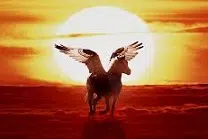 In Greek mythology, Pegasus was a horse that had wings . According to myth, he was born from the blood of Medusa , whom Perseus beheaded.
In Greek mythology, Pegasus was a horse that had wings . According to myth, he was born from the blood of Medusa , whom Perseus beheaded.
Pegasus was the horse of Zeus and, thanks to his pair of wings, he could fly. Beyond the use of the wings, when moving through the air it also moved its legs, as if "running" although without stepping on the ground.
In this context we can talk about the Greek mythological hero Bellerophon , Bellerophon or Bellerophontes . Depending on the tradition we study, it is said that his parents were Eurymede and Glaucus of Corinth or Eurynome and Poseidon. His real name was Leophontes or Hipónous; He began to be known as Bellerophontes after accidentally killing Belero, a tyrant of Corinth, since Bellerophontes can be translated as "murderer of Bellero."
The story goes that Pegasus was indomitable. Obsessed with it, Bellerophon finally managed to master it and the winged horse was key in his victory against the Chimera , a beast which he managed to kill. Proud of himself, Bellerophon sought to establish himself as a god, heading with Pegasus to Olympus .
The Chimera beast is another character from Greek mythology that has been the protagonist of numerous stories. In his case it was not a well-defined animal, like Pegasus, but a hybrid of several species and with three heads: one of a goat, one of a dragon and one of a lion, although this may vary depending on the source. Among his special abilities is that he was able to breathe fire.
However, Zeus , dissatisfied with this situation, made an insect bite Pegasus , who became agitated and threw Bellerophon to the ground, seriously injuring him. Zeus then granted Pegasus a place on Olympus .
The buraq , an equine from Islamic mythology, is likely inspired by the figure of Pegasus. Buraq is said to have taken Muhammad to Heaven and brought him back to Earth.
Pegasus , on the other hand, is a constellation whose brightest star is Enif , followed by Scheat . This constellation was among those mentioned by Claudius Ptolemy in the 2nd century .
Given the characteristics of Pegasus, in modern times it became one of the most used mythological animals in fiction , both in literature and in cinema. In addition, it led to the creation of many others with similar characteristics. It shares with the unicorn the ability to fascinate the public and generate a very particular mysticism , but it is also an inevitable companion of many Greek heroes and gods in their fierce battles.
 We can mention three works of Japanese cartoons in which the name Pegasus appears in one of the most important roles: in Saint Seiya , for example, the protagonist is a knight of the Pegasus constellation, and is related to Hades and Athena; in Sailor Moon , he is the one who protects dreams; In Beyblade Metal Fusion , finally, he is the main character.
We can mention three works of Japanese cartoons in which the name Pegasus appears in one of the most important roles: in Saint Seiya , for example, the protagonist is a knight of the Pegasus constellation, and is related to Hades and Athena; in Sailor Moon , he is the one who protects dreams; In Beyblade Metal Fusion , finally, he is the main character.
In the West there are also various examples, both in animated films and live action . In this way, we can mention titles such as Hercules , from Disney Pictures, Clash of the Titans , both the 1981 and 2010 versions, and also Wrath of the Titans .
The Pegaso brand, meanwhile, was created in Spanish territory in 1946 . It was a car, truck and other vehicle company that, in 1990 , was acquired by the Italian company Iveco . His Pegaso Z-102 sports car is among his best-known models, being manufactured between 1951 and 1958 .
NEE-01 Pegasus , finally, is the name of the first artificial satellite that was built in Ecuador . This nanosatellite developed by the Ecuadorian Civil Space Agency was launched in 2013 from China .
